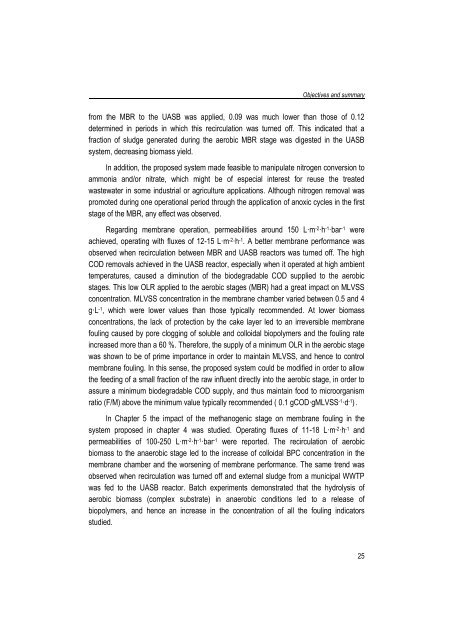Combining submerged membrane technology with anaerobic and ...
Combining submerged membrane technology with anaerobic and ...
Combining submerged membrane technology with anaerobic and ...
You also want an ePaper? Increase the reach of your titles
YUMPU automatically turns print PDFs into web optimized ePapers that Google loves.
Objectives <strong>and</strong> summaryfrom the MBR to the UASB was applied, 0.09 was much lower than those of 0.12determined in periods in which this recirculation was turned off. This indicated that afraction of sludge generated during the aerobic MBR stage was digested in the UASBsystem, decreasing biomass yield.In addition, the proposed system made feasible to manipulate nitrogen conversion toammonia <strong>and</strong>/or nitrate, which might be of especial interest for reuse the treatedwastewater in some industrial or agriculture applications. Although nitrogen removal waspromoted during one operational period through the application of anoxic cycles in the firststage of the MBR, any effect was observed.Regarding <strong>membrane</strong> operation, permeabilities around 150 L·m -2·h -1·bar -1 wereachieved, operating <strong>with</strong> fluxes of 12-15 L·m -2·h -1 . A better <strong>membrane</strong> performance wasobserved when recirculation between MBR <strong>and</strong> UASB reactors was turned off. The highCOD removals achieved in the UASB reactor, especially when it operated at high ambienttemperatures, caused a diminution of the biodegradable COD supplied to the aerobicstages. This low OLR applied to the aerobic stages (MBR) had a great impact on MLVSSconcentration. MLVSS concentration in the <strong>membrane</strong> chamber varied between 0.5 <strong>and</strong> 4g·L -1 , which were lower values than those typically recommended. At lower biomassconcentrations, the lack of protection by the cake layer led to an irreversible <strong>membrane</strong>fouling caused by pore clogging of soluble <strong>and</strong> colloidal biopolymers <strong>and</strong> the fouling rateincreased more than a 60 %. Therefore, the supply of a minimum OLR in the aerobic stagewas shown to be of prime importance in order to maintain MLVSS, <strong>and</strong> hence to control<strong>membrane</strong> fouling. In this sense, the proposed system could be modified in order to allowthe feeding of a small fraction of the raw influent directly into the aerobic stage, in order toassure a minimum biodegradable COD supply, <strong>and</strong> thus maintain food to microorganismratio (F/M) above the minimum value typically recommended ( 0.1 gCOD·gMLVSS -1·d -1 ) .In Chapter 5 the impact of the methanogenic stage on <strong>membrane</strong> fouling in thesystem proposed in chapter 4 was studied. Operating fluxes of 11-18 L·m -2·h -1 <strong>and</strong>permeabilities of 100-250 L·m -2·h -1·bar -1 were reported. The recirculation of aerobicbiomass to the <strong>anaerobic</strong> stage led to the increase of colloidal BPC concentration in the<strong>membrane</strong> chamber <strong>and</strong> the worsening of <strong>membrane</strong> performance. The same trend wasobserved when recirculation was turned off <strong>and</strong> external sludge from a municipal WWTPwas fed to the UASB reactor. Batch experiments demonstrated that the hydrolysis ofaerobic biomass (complex substrate) in <strong>anaerobic</strong> conditions led to a release ofbiopolymers, <strong>and</strong> hence an increase in the concentration of all the fouling indicatorsstudied.25
















